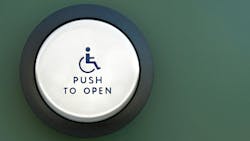Are your facility’s doors ADA-compliant? The wrong interior or exterior doors can affect your ability to achieve full compliance—and put you at risk for a lawsuit if someone in your building isn’t able to access the places they need to go. Here’s how door specifications can make your building more or less accessible—and what you can do if you’re not in compliance.
What Are the ADA Requirements for Doors?
The 2010 ADA Standards for Accessible Design lay out everything a building owner or manager needs to know about complying with ADA requirements. These standards should be the first stop for anyone who’s questioning whether something in a facility is compliant. Many requirements pertain to doors, but some of the ones that often cause issues for building owners and managers include:
- Clear openings: Door openings must provide a clear width of at least 32 inches. If a doorway has a swinging door, its clear opening is measured between the face of the door and the stop, with the door open 90 degrees; an opening larger than 24 inches should provide a clear opening of at least 36 inches. There can be no projections into the required clear opening width lower than 34 inches above the finish floor or ground. Projections into the clear opening width between 34 and 80 inches above the floor or ground cannot exceed 4 inches.
- Maneuvering clearances: ADA sets minimum limits for clearances at doors and gates, with exceptions made for entry doors to hospital patient rooms, as well as doorways that don’t have doors or gates attached.
- Closers and hinges: Starting from an open position of 90 degrees, door and gate closers should take at least five seconds to move the door to a position of 12 degrees from the latch. Spring hinges should move from an open position of 70 degrees to a closed position in 1.5 seconds at minimum.
- Opening force: Fire doors have a minimum opening force allocated by administrative authorities. ADA requires an opening force of 5 pounds maximum for interior hinged doors and gates, as well as sliding or folding doors. This requirement doesn’t apply to the force required to retract latch bolts or disengage other devices that hold the door or gate closed.
- Revolving doors: Turnstiles and revolving doors and gates cannot be part of an accessible route. “The biggest misconception when thinking about ADA compliance is that design modifications are only made to consider wheelchair accessibility. ADA compliant design creates accessible spaces for people with a wide range of physical disabilities, including hearing or visual impairments and fine motor disabilities,” said Tricia Ebner, director at MdeAS Architects. “One of the biggest challenges present in older buildings is lack of compliant access at doors—both in terms of clearance and operation.”
How Doors Can Fall Out of ADA Compliance
Most buildings have the correct doors specified, but they can run into issues after installation that put compliance in jeopardy, explained Tysen Gannon, business development and marketing consultant for AD Systems, which designs high-performance doors.
“Occasionally, you’ll see things like installation issues where the door or the hardware weren’t installed properly, and there’s a clearance issue or it’s too difficult to operate,” Ganon said. “It will come up post-install that it’s not meeting the intent or the explicit requirements of ADA.”
ADA doesn’t specify the types of hardware you’ll need to use with the door, but the 2010 design standards suggest that “Door hardware that can be operated with a closed fist or a loose grip accommodates the greatest range of users. Hardware that requires simultaneous hand and finger movements requires greater dexterity and coordination, and is not recommended.”
A clearance of about an inch and a half around the hardware is usually needed to operate a door with a closed hand, Gannon said. “Test the levers to see if it’s operable with a closed fist or if a thumb turn can be operable using a closed hand,” Gannon suggested. “It should need no pinching, twisting, or grasping on the hardware. That’s a big one.”
Doors that stick are likely not compliant either, as they would require more than five pounds of force to open, Ebner added.
What To Do If Your Doors Don’t Comply with ADA
There are a few potential solutions if you have a door that’s not in compliance, especially if you’re open to replacing the hardware or even the whole door. There are many alternatives to traditional swing doors, many of which fall under the automatic operating door umbrella. “It’s become more common to use sliding doors in interior applications,” Gannon said. “You see a lot of different configurations of doors that are different from traditional swing doors, and they now have ADA-compliant operation because the hardware has become more sophisticated.”
Automatic doors are common in buildings created with the principles of universal design in mind because pushing a button is so much easier than operating a door manually, Gannon added. This ease of access should be a driving factor in deciding how to specify doors and hardware.
“Considering the path of movement of a person through space is really important to understanding accessibility,” Gannon said. “How many openings are they having to pass through? If you’re considering an occupant who has restrictions on their mobility, their journey through that space from Point A to Point B is really important to consider, and it’s very difficult to codify. Try to make movement easier with the path of travel through a space.”
About the Author
Janelle Penny
Editor-in-Chief at BUILDINGS
Janelle Penny has been with BUILDINGS since 2010. She is a two-time FOLIO: Eddie award winner who aims to deliver practical, actionable content for building owners and facilities professionals.


